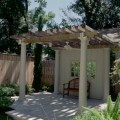Patio Landscaping
A patio is a form of architecture that creates a special area of interest. Patio landscaping requires taking a number of essential considerations in mind when creating a new design. We pay close attention to the architecture of the home in order to ensure that that every patio we build compliments its size and form. Garden styles are another major influence on patio landscaping. Gardens are very often planted near patios, and the two have a direct bearing on one another’s appearance. Many times as well, patio landscaping must be designed to accommodate specific outdoor structures that contribute both function and form to the landscape.
Patio landscaping is both an extension of and a compliment to home architecture. When people move from interior space into outdoor space, many times the first thing they set foot on is a patio that creates an experience alone just by walking on it. The size, shape, and surface materials used to construct it will all combine together into a unity that creates an experience unique unto itself. Depending on the design and intention of its construction, a patio can do many things. It can function as a central hub that unites garden design, swimming pool aesthetic, and the corresponding structure of the house into a constructed landscape that blends harmoniously with the natural. This does not mean, however, that a patio serves an exclusively utilitarian purpose in landscaping design. The same patio you walk on may be also a very decorative work of art. Patios of interests, such as the popular checkerboard design, are often used to create unconscious reflections of contemporary home architecture or outdoor sculptures.
Patio landscaping can also be a part of garden design. Gardens are often planted around patios in order to bring their scale in and create rooms by the planting. Making the right material selection is very important such instances. Stone patios look more natural and lend themselves very well to a more traditional, organic aesthetic. Concrete and aggregate constructions are often used to create contrasts or sharp points of differentiation between organic elements and exterior forms that serve a more practical purpose for outdoor living. It is not uncommon for, for example, for clients to ask us to build a patio between a garden area and an outdoor room of some sort in order to provide transition from purely decorative space to functional space.
In fact, patio landscaping is an almost mandatory component to the construction of many outdoor structures. Seating areas are needed around places like French fountains and Zen gardens. These smaller patios serve to separate the landscape into a division of public space and private space–giving residents to have a special part of their yard set aside just for themselves. Larger gathering areas are sure to have a high demand for seating, and this will almost always require construction a large enough patio that is specifically scaled to host an expected number of guests. This is most commonly done around a swimming pool, but it can also be done in an area that lies between a number of outdoor rooms and elements. Outdoor kitchens, outdoor fire pits, and outdoor fireplaces are other structures that typically require a surrounding or adjoining patio to provide outdoor seating, décor, and a sense of entryway that differentiates the structure as an experience unique unto itself.



